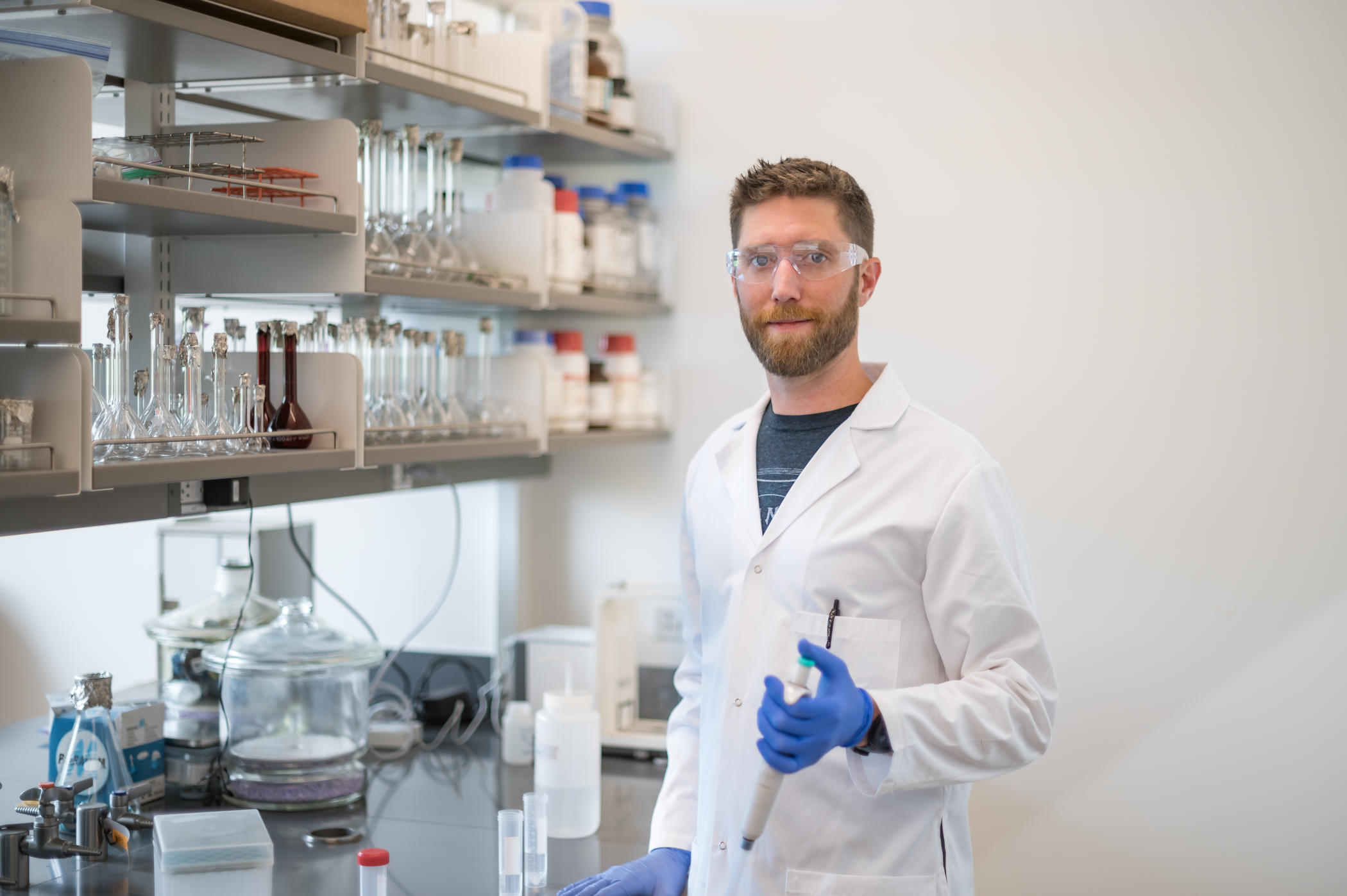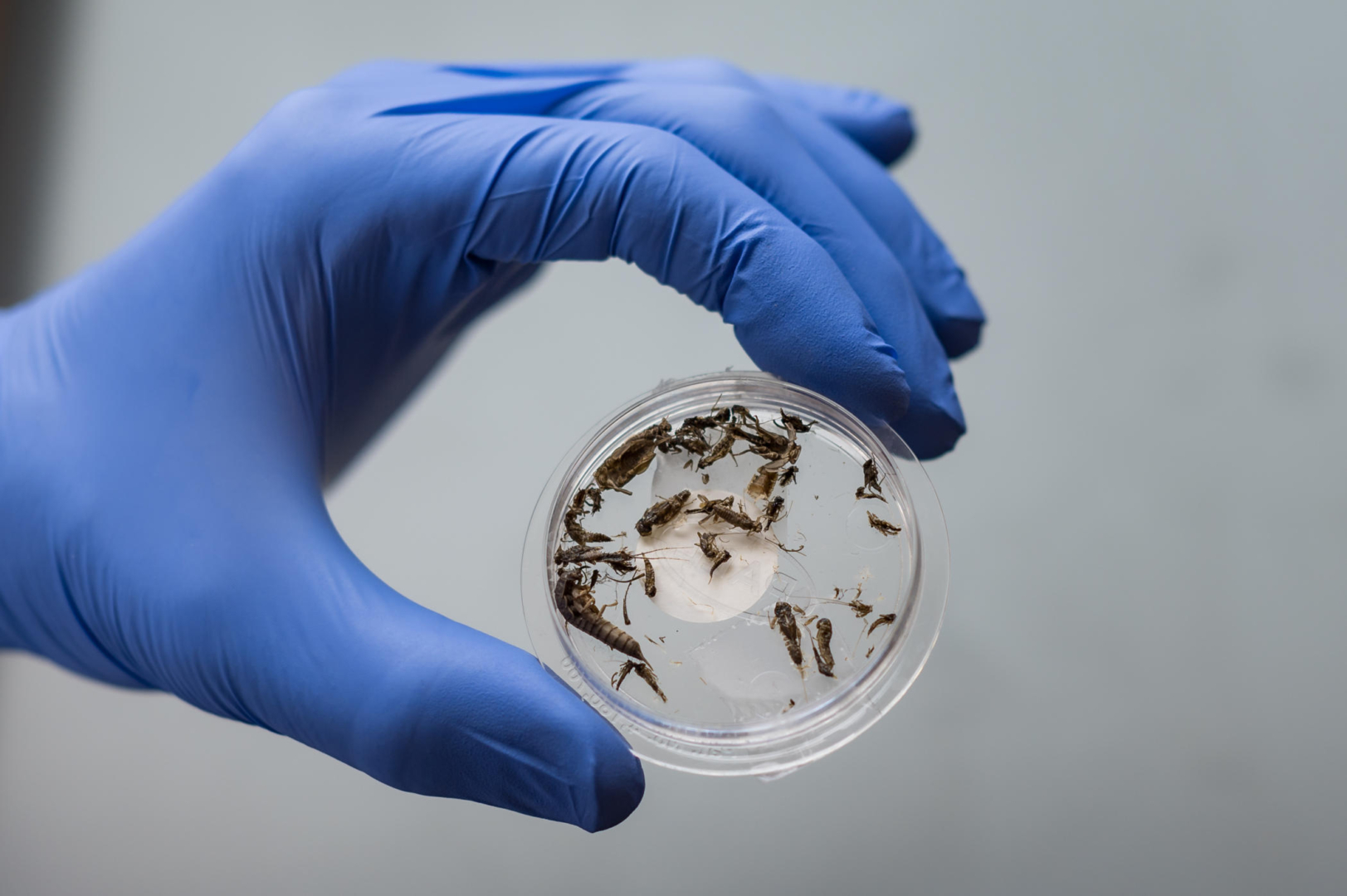Student Fly-Fisherman Casts His Line into Researching Local Creeks

Maurice Ledoyen, an outstanding graduate in Environmental Science, is conducting his Honors research studying metal accumulation in aquatic organisms (benthic macro-invertebrates) in creeks affected by the Camp Fire on Monday, April 18, 2022 in Chico, Calif. (Jason Halley/University Photographer/Chico State)
Maurice Ledoyen remembers the day clearly. It was a Wednesday in late August 2019, and he was sitting in Monica So’s “General Chemistry I” class in Butte Hall—his first time in a college classroom in 10 years.
He pulled out his phone and texted his sister, “I’m not sure I’m going to make it.”
It took until the first round of midterms for the environmental science major to believe he belonged at a university. But in the time since, he’s done more than just make it. According to Sandrine Matiasek, his professor in several geological and environmental science courses, he’s finished her classes with near-perfect grades, an academic performance that she hasn’t seen in 10 years of teaching, and become a consummate scholar with great research promise.
“Maurice has a deep appreciation and love for the creeks in the North State,” said Matiasek. “I feel so fortunate he has been able to harness local knowledge and his passion for the work that we are doing on all the local watersheds in the area.”
In particular, Ledoyen really stood out in the graduate-level “Natural Water Systems,” which is known for being a very difficult class where many students struggle. Matiasek remembers Ledoyen not only thriving but mentioning he hoped she would have moved through the material more quickly.
“I first met Maurice during the pandemic when all classes were online. Even though we were on Zoom, he was engaged in discussions and asked great questions. He’s very professional and his passion for the material stood out,” Matiasek said.
She was delighted when Ledoyen reached out expressing a desire to broaden his experience beyond the classroom. That initial conversation led to Ledoyen conducting his honors research in her Environmental Chemistry Lab, studying the effects of metal accumulation in aquatic fly larvae (benthic macroinvertebrates) in creeks affected by the Camp Fire.
When a megafire destroys everything in its path, both natural and human-sourced contaminants, including metals, enter the environment. Some end up in local streams during storm events.
Working in collaboration with the Chico State Aquatic Bioassessment Lab, Ledoyen has spent the last eight months collecting and sorting the larvae samples and classifying them as either consumer or predator species. One of his goals is to assess whether metal accumulation progresses through the food chain.
He’s grateful to have access to a brand-new Inductivity Coupled Plasma Spectrometer provided by a $286,000 grant from the National Science Foundation Matiasek and her colleagues were awarded to support their work. Preliminary results are just coming in, but they indicate evidence of metals in the creeks that receive storm runoff from the burned watersheds.
This is concerning for the long-term health of the aquatic ecosystem, including the threatened spring run of Chinook salmon that spawn in Butte Creek, Ledoyen said.
He’s also tracking the metals’ movement downstream as the area creeks dump into the Sacramento River. He hopes the results of this study will be helpful to scientists throughout the Western United States who must assess post-wildfire water quality.

“I’m an avid fly-fisherman who grew up in the area, so I’ve spent a lot of time on all our local creeks. That’s what led to my interest in our aquatic environments and this research into our local waterways,” he said. “This research is sort of my way to give back to an area that I love.”
Ledoyen grew up just a stone’s throw from Chico State, but his path to the campus was anything but straightforward. After high school, he started at Butte College in 2010 because community college seemed like the logical next step. He didn’t connect with his major and his experience wasn’t what he expected. So, he decided to leave school and became a successful welder. When a severe shoulder injury ended his welding career, he began to consider returning to college.
“If I never tore up my shoulder, I likely never would have come back to Chico State. But it has been a blessing,” said Ledoyen. “This go-around, I was ready to come in and work hard. I’ve really connected with Sandrine and my peers, and it is inspiring being around so many smart and talented students who are much younger than I am.”
In addition to working in Matiasek’s lab, Ledoyen has served as one of three student assistants for the Big Chico Creek Watershed Tour. The tour, made possible by the Center for Water and the Environment (CWE), enables students to work directly with faculty and learn about the creek that runs through campus in a hands-on way.
Ledoyen’s long-term goals are to attend graduate school—he’s been accepted at Matiasek’s alma mater, University of California, Davis—and work as a hydrologist in the field of physical hydrology, which is the study of river process and form.
No matter where he ends up, he said, his heart and professional focus will always have a fly line back to Big Chico and Butte Creeks.


